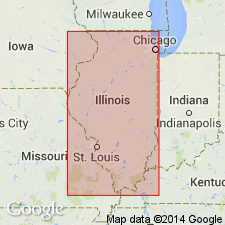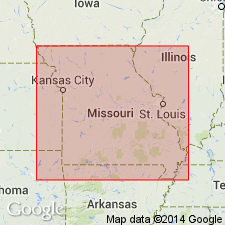
- Usage in publication:
-
- Kingdom formation
- Modifications:
-
- Original reference
- Dominant lithology:
-
- Sandstone
- AAPG geologic province:
-
- Wisconsin arch
Summary:
Figs. 3, 12. Kingdom formation of Ancell group. Consists of argillaceous silty fine- and coarse-grained sandstone about 9 feet thick. Shown on columnar section as underlying Daysville formation (new) and unconformably overlying St. Peter sandstone. Age is Middle Ordovician.
[Notable exposures in Dixon-Oregon area, northern IL.]
Source: US geologic names lexicon (USGS Bull. 1200, p. 2015).

- Usage in publication:
-
- Kingdom Sandstone Member
- Modifications:
-
- Overview
- AAPG geologic province:
-
- Wisconsin arch
Summary:
Pg. 53 (fig. O-4), 63 (fig. O-15), 64. Kingdom Sandstone Member of Glenwood Formation of Ancell Group (J.S. Templeton and H.B. Willman, 1963, Illinois Geol. Survey Bull., no. 89). Thickness 0 to 40 feet; 7.9 feet thick at type section. Basal member of Glenwood Formation. Underlies Daysville Dolomite Member of Glenwood. Overlies Tonti Sandstone Member of St. Peter Sandstone. Equivalent to lower part of Nokomis Member of Glenwood farther north. Age is Middle Ordovician (Blackriverian).
Type section: ravine in NE/4 SE/4 NW/4 sec. 36, T. 23 N., R. 9 E., 3 mi north of Kingdom, [Grand Detour 7.5-min quadrangle], Ogle Co., northern IL. Named from Kingdom, [Grand Detour 7.5-min quadrangle], Lee Co., northern IL.
Source: Publication.

- Usage in publication:
-
- Kingdom Member
- Modifications:
-
- Overview
- AAPG geologic province:
-
- Lincoln anticline
Summary:
Pg. 154. Kingdom Member of St. Peter Sandstone. Sandy to shaly, forms lower beds of Glenwood Formation to north and separates Starved Rock and Tonti Members of the St. Peter Sandstone to south. Age is Ordovician (Mohawkian).
(See also T.L. Thompson, 1991, Paleozoic succession in Missouri, Missouri Div. Geol. Land Survey Rpt. Inv., no. 70, Part 2, Ordovician System, 282 p.)
Source: Publication.
For more information, please contact Nancy Stamm, Geologic Names Committee Secretary.
Asterisk (*) indicates published by U.S. Geological Survey authors.
"No current usage" (†) implies that a name has been abandoned or has fallen into disuse. Former usage and, if known, replacement name given in parentheses ( ).
Slash (/) indicates name conflicts with nomenclatural guidelines (CSN, 1933; ACSN, 1961, 1970; NACSN, 1983, 2005, 2021). May be explained within brackets ([ ]).

